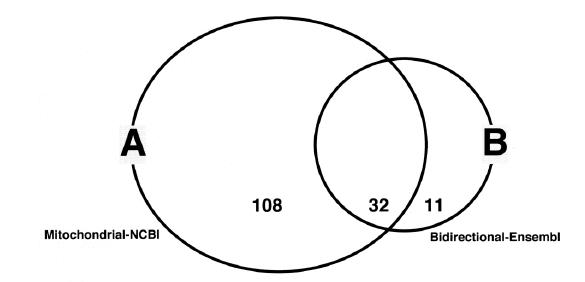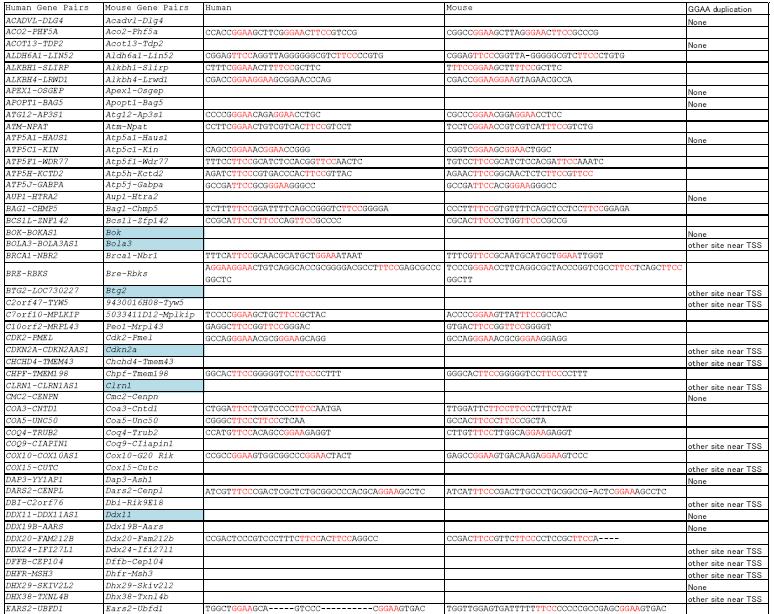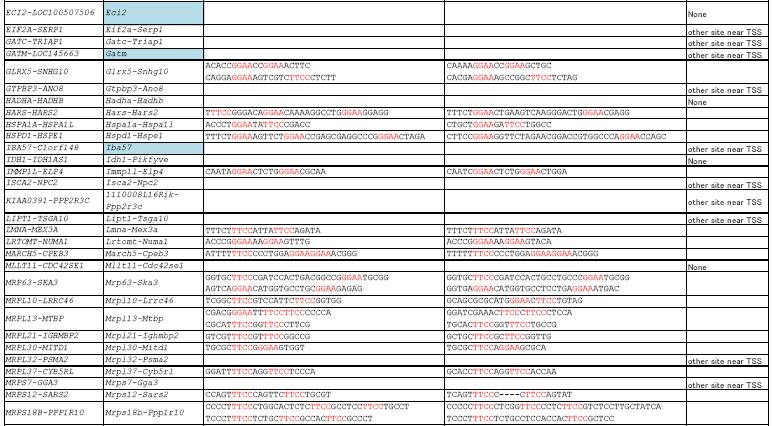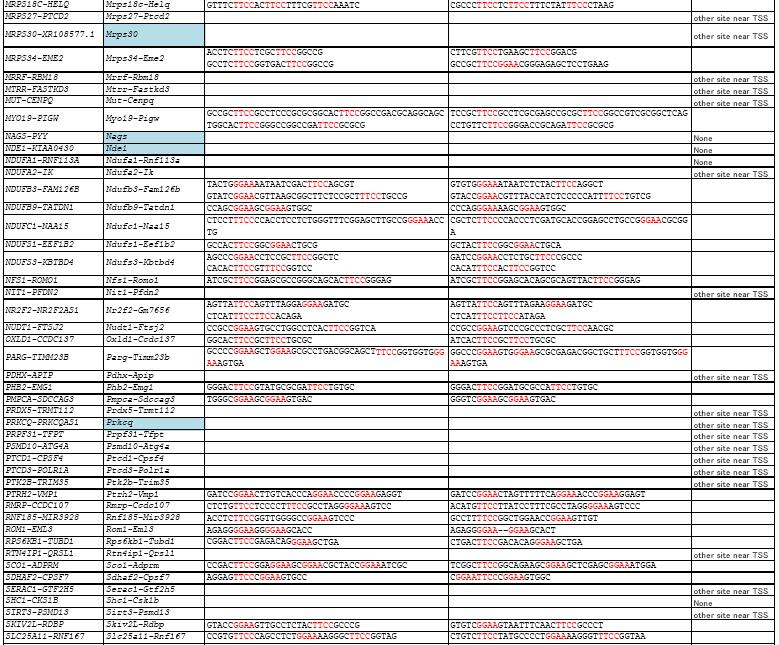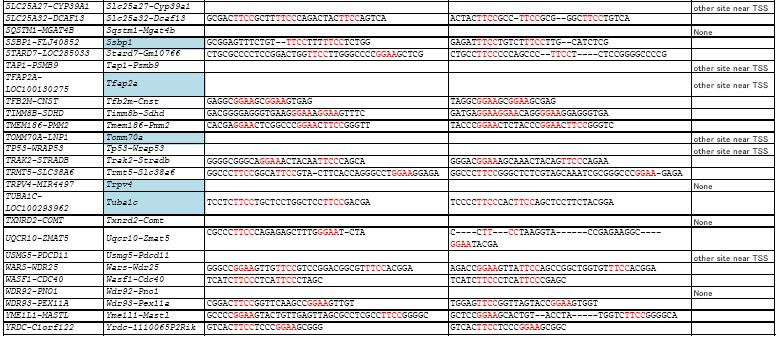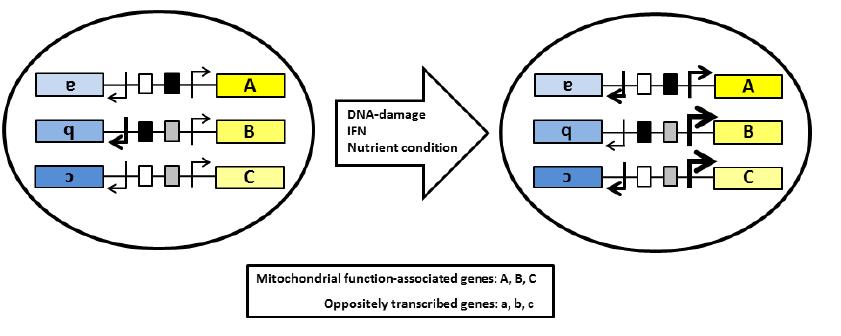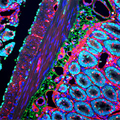1. Introduction
Molecular mechanisms of transcription from chromosomal DNA in eukaryotic cells have been well studied. It is widely known that transcription in eukaryotic cells is executed by three major RNA polymerases (pols)I, II, and III, which catalyze synthesis of the majority of ribosomal RNAs (rRNAs), mRNAs, and tRNAs, respectively. Among these, the molecular mechanism of transcription involving RNA pol II has been the most characterized [1]. Mitochondria, which carry their own circular genomic DNA (mtDNA), transcribe several RNAs that are required for mitochondrial functions [2]. Three distinct promoters, LSP, HSP1 and HSP2 are located in the mtDNA to express several protein encoding RNAs, tRNAs and rRNAs [3]. Thus, mitochondria have their specific transcription system that is separated from eukaryotic nuclear transcription and controlled by mitochondrial transcription factors, including mitochondrial RNA pol (POLRMT), TFB1M, TFB2M, and transcriptional activator TFAM [3]. Nevertheless, most of the mitochondrial or their function-associated proteins, which comprise 99% of mitochondrial proteins, have to be translated from mRNAs that are synthesized from nuclear genomic DNAs [4]. Mitochondrial proteome analysis showed that more than 1, 000 different proteins are included in mitochondria [5]. After translation and modification, they are imported from the cytosol by two import pathways [6]. A variety of functions for these proteins, including energy metabolism (15%), protein synthesis (13%), genome maintenance and transcription (12%), and protein transport (7%), are suggested from the functional classification of the yeast mitochondrial proteome [6,7]. Those nuclear genes encoding mitochondrial function-associated proteins are likely to be regulated by a common system to form a mitochondrion as a huge complex composed of various proteins, nucleic acids, and other materials to supply energy required for cell survival.
From the analysis of promoter regions of cytochrome c (CYCS) and cytochrome oxidase subunit IV (COX9) showed that transcription factors NRF1 and NRF2 are involved in the regulation of expression of these genes [8,9]. Other transcription factors, such as estrogen-related receptor ERR, PGC-1, and PGC-1, are thought to be involved in the regulation of the mitochondrial gene expression system [2]. Previous studies of the promoter region of the human poly (ADP-ribose)glycohydrolase (PARG)gene, whose encoding protein PARG is shown to be localized in mitochondria [10], showed that it contains duplicated c-ETS binding sequences or GGAA-motifs and that it is linked with the most 5’region -upstream of the mitochondrial gene TIMM23B in a head-head configuration [11,12]. Moreover, we have a identified that a similar bidirectional promoter region between the IGHMBP2 and the MRPL21 genes has duplicated c-ETS binding- or GGAA-motifs [13]. The TIMM23B and the MRPL21 genes encode a protein component of the TIM23 complex and a large subunit of the mitochondrial ribosomal protein complex, respectively [6,14]. These findings suggest that some of the mitochondrial genes might be regulated by bidirectional promoters that contain duplicated GGAA-motifs.
In this review article, we will discuss the results of investigations to select promoter regions of the human genes encoding mitochondrial or mitochondrial function-associated proteins, and confirm that quite a few bidirectional gene pairs are included in the list. We also discuss the results of genome-informatic surveillance of the Ensembl database to find human genomic regions in which two genes are configured head-head, sharing the same 5’-flanking region, which regulates transcription in opposing directions for each gene.
2. Bidirectional promoters that are found in DNA-repair associated genes and 5’-upstream regions containing duplicated GGAA-motifs
Because we have identified the bidirectional partners for the PARG and the IGHMBP2 genes, which are thought to be involved in the DNA repair synthesis system in eukaryotic cells, we searched 5’-upstream regions of several DNA-repair associated genes [15]. For example, TP53/WRAP53 and APEX1/OSGEP gene pairs are linked by bidirectional promoter regions. Interestingly, it has been shown that p53, which is encoded by the TP53 gene, and the APEX1 (APE1)proteins are reported to be involved in mitochondrial functions [16,17,18], and mitochondrial DNA repair [19,20], respectively. The palindromic c-Ets element, which is located near the transcription start site (TSS)of the TP53 promoter [21], has an essential role in its regulation [22].
The essential role of the duplicated GGAA-motifs in the PARG promoter has been reported [12,23]. Additionally, the duplicated GGAA-motifs were identified in the 5’-flanking regions of the DNA-repair associated genes, including XPB, Rb1, and ATR [24]. A comparison of the duplicated GGAA-motifs of these gene regulatory regions tentatively determined a consensus 14-bp sequence as 5’-(A/G/C)N(A/G/C)(C/G)(C/G)GGAA (A/G)(C/T)(G/C/T)(A/G/C)(A/G/C)-3’ or 5’-VNVSSGGAARYBVV-3’ in IUPAC code [24]. Thus we explored the duplicated 14-bp sequences within 2, 000-bp upstream and 200-bp downstream of 47, 553 genes extracted from the Ensembl data base [25]. The c and idate sequences were found near the TSSs of 234 genes. Re-confirmation of the 5’-upstream regions of these 234 genes revealed that 21 pairs of protein encoding genes, including MRPL32/PSMA2, NDUFB3/FAM126B, NDUFS3/KBTBD4, SDHAF2/CPSF7, and YRDC/C1orf122, are linked to each other in a head-head configuration [25]. The MRPL32 gene encodes a 39S subunit of the L32 mitochondrial ribosomal protein [14]. The NDUFB3 and NDUFS3 genes encode NADH dehydrogenase (ubiquinone) 1β subcomplex 3 and Fe-S protein 3, respectively [26]. These are the components of the NADH dehydrogenase or complex I, which consists of 45 subunits with a combined mass of 980-kDa [26]. SDHAF2 (succinate dehydrogenase complex assembly factor 2)is a protein that activates a succinate dehydrogenase complex subunit by flavination [27]. Activation of this enzyme complex is needed not only for the citrate cycle but also for the electron transport system. YRDC (yrdC domain containin g)protein, which is suggested to have properties of a putative threonylcarbamoyl transferase [28], might also affect mitochondrial tRNA synthesis. These observations suggest the hypothesis that some of the mitochondrial function associated genes might be located near the 5’-upstream regions of other nuclear genes utilizing the same transcription regulatory elements to direct transcription in the opposite direction.
3. Survey of putative bidirectional promoter regions from Ensembl data base
As shown in Table 1, computer-based in silico analysis retrieved 240 bidirectional gene pairs from the Ensembl database covering approximately 50, 000 human genes. The sequences between two genes were reconfirmed using the National Center for Biotechnology Information (NCBI)nucleotide database (http://www.ncbi.nlm.nhi.gov/nuccore/). Twelve gene pairs (Table 1, characters in green)were found to be separated over 500 nucleotides and were eliminated from the total number. As indicated in Table 1, at least 72 gene pairs contain mitochondria associated genes (31.6%), including 11 mitochondrial-mitochondrial gene pairs (4.82%). The remaining 156 gene pairs, which include twelve pairs of histone protein-encoding genes, are not directly associated with mitochondria but with DNA-repair, replication, transcription, translation, apoptosis, and other cellular functions. Interestingly, surveillance of the genomic database revealed that RPL9, RPS18, and RPS28 genes, which encode components of ribosomal protein subunits, have bidirectional partners. In addition, EIF3I and EIF2B1 genes are also listed in Table 1, suggesting that some of the ribosomal protein-encoding genes are controlled by bidirectional promoters.
Table 1. Bidirectional promoter pair genes retrieved from Ensembl database
We have hypothesized that duplicated GGAA-motifs are frequently found in bidirectional promoters, so we therefore surveyed whether 630-bp regions covering both TSSs of gene pairs have duplicated GGAAs. It was confirmed that 54 out of 72 (75%)of mitochondrial, and 112 out of 156 (71%)of non-mitochondrial gene pairs possess duplicated GGAA-motifs. The observation suggests that the frequency of localization of GGAA duplication within 630-bp of the bidirectional promoter is not dependent on the biological functions or localizations of these gene-encoding products. Although the IGHMBP2/MRPL21 gene pair is listed in Table 1, TP53/WRAP53 and PARG/TIMM23B gene pairs were not retrieved from the Ensembl database, suggesting that other bidirectional partners of mitochondrial function related genes could be found from other nucleotide databases. Therefore, we decided to search bidirectional partners of mitochondria-associated genes from the NCBI database.
Two hundred and forty (240) bidirectional gene pairs that were extracted from the Ensembl database are shown. Genes indicated by red characters represent pseudo genes. Green colored characters indicate gene pairs that are separated over a distance of 500 nucleotides. Numbers of chromosomes are shown on the left of each gene pair. Mitochondrial or their function-associated genes are indicated by yellow background. Non-colored background represents genes whose encoding protein's functions or localizations are unknown at present (Jan.31.2013).
4. Survey of 5’-flanking regions of human mitochondrial- or mitochondrial function associated genes
A list of human genes encoding mitochondria or their function associated proteins was obtained from the NCBI Entrez cross-database search (http://www.ncbi.nlm.nih.gov/sites/gquery). This database holds 3, 006 genes, including not only directly mitochondrial function-associated protein encoding genes, but also indirectly associated or function-unknown protein-encoding genes. First, we omitted non-coding RNA sequences and pseudo genes from the list and searched 5’-upstream regions of each gene to find 549 head-head linked gene pairs. Next, 233 gene pairs that are separated from each other but within 500-bp in distance were selected. Some of these pairs had overlapping 5’-untranslated regions. The duplicated GGAA motifs were then searched in the TSS containing 630-bp regions to select 140 gene pairs (Fig. 1, Group A). This group contained the same 32 gene pairs that were retrieved from the Ensembl data base (Fig. 1, Group B). Thus, we obtained a list of 151 gene pairs (Table 2)that are thought to be associated with mitochondria or their functions and that are head-head configured within 500-bp distances carrying at least one apparent duplicated GGAA-motif near putative TSSs. Most of these bidirectional promoters do not have apparent TATA boxes in common, suggesting that they might belong to TATA-less promoters [29].
Table 2. GGAA motifs located in the 5’-upstream regions of head-head oriented pairs of human genes encoding mitochondrial proteins
| Gene | Sequence |
| ACADVL-DLG4 | TCTCTTTCCCTACTTTTCCCTTCT |
| ACO2-PHF5A | CCACCGGAAGCTTCGGGAACTTCCGTCCG |
| ACOT13-TDP2 | GGACTTTCCAGCTCTTCCGAAGT |
| ALDH6A1-LIN52 | CGGCGGGAAAACGAGGTTCCATAAG |
| ALKBH1-SLIRP | GCCCCGGAAAAAATTTCCGGATCCGGAACACGA, CTTTCGGAAACTTTTCCGCTTC |
| ALKBH4-LRWD1 | CGACCGGAAGGAAGCGGAACCCAG |
| APEX1-OSGEP | CACTGGGAAAGACACCGCGGAACTCCC, CCGTTTTCCTATCTCTTTCCCGTGG |
| APOPT1-BAG5 | GACGCTTCCACGACTTCCGCAGC, TGACCGGAAGGGAAGACAA |
| ATG12-AP3S1 | ACTAAGGAAAGCGGAAACATT, CCGTCTTCCGCTGCAGTTTCCCCGGGAACAGAGGAACCTGC |
| ATM-NPAT | CAGCAGGAACCACAATAAGGAACAAGA, CCTTCGGAACTGTCGTCACTTCCGTCCT |
| ATP5A1-HAUS1 | GGGCAGGAAGGGAAAGGCC, GCCACTTCCCAGCTCTTCCCGCCTTCCGCGGT |
| ATP5C1-KIN | CAGCCGGAAACGGAACCGGG |
| ATP5F1-WDR77 | TTGGGGGAAGATTCCACTCC, GGGGTTTCCTTCCGCATC, CCCAAGGAAAGTTGAAGGAAGAGTA |
| ATP5H-KCTD2 | CCCCGGGAAGATACTTCCGGAACCAGC, GCTGAGGAAAGATCTTCCCGTGACCCACTTCCGTTAC |
| ATP5J-GABPA | GCCGATTCCGCGGGAAGGGCC, CCTCGTTCCGGGGCCTTTTCCCCCAC |
| AUP1-HTRA2 | CAGTAGGAAGCAGTCACCCGGAAGCCTG |
| BAG1-CHMP5 | GGCGTTTCCCGATTCTTTTTCCGGATT |
| BCS1L-ZNF142 | CCTCCTTCCGAGAGTTCCCAGCG, CCGCATTCCCTTCCCAGTTCCGCCCC |
| BOK-BOKAS1 | AGCGGGGAAGCTCGGAAAGCGT |
| BOLA3-BOLA3AS1 | GAGTGGGAATGGAAAAGTA |
| BRCA1-NBR2 | ATGCTGGAAATAATTATTTCCCTCCA, AATTCTTCCTCTTCCGTCTCTTTCCTTTTA, TTGGTTTCCGTGGCAACGGAAAAGCGCGGGAATTACA |
| BRE-RBKS | TCTTCTTCCTGGAATAGTC, GCTGAGGAAGGAACTGTC |
| BTG2-LOC730227 | CCACGGGAAGGGAACCGAC |
| C2orf47-TYW5 | CCCTCTTCCAGGTCTTCGGAACTTCG, GCGGTTTCCCACCGACTTCCTTTCCATACA |
| C7orf10-MPLKIP | CGGGGTTCCCCGGAAGCTGCTTCCGCTAC |
| C10orf2-MRPL43 | GAGGCTTCCGGTTCCGGGAC, TGAGGGGAAGGAGAAGCGGAAGAGGG |
| CDK2-PMEL | CGAGATTCCCGGCTTCCTGGTTTCCAAAGG, GCCAGGGAAACGCGGGAAGCAGG |
| CDKN2A-CDKN2AAS1 | AGCCAGGAATAAAATAAGGGGAATAGGG |
| CHCHD4-TMEM43 | TGCTGGGAAATGTAGTTTCCGGCTG |
| CHPF-TMEM198 | CCTGAGGAAGGGGAAGGCGC, GGCACTTCCGGGGGTCCTTCCCCTTT |
| CLRN1-CLRN1AS1 | GCTGAGGAAGGGAAACATT |
| CMC2-CENPN | GGCCGTTCCGAACGCGTTCCGTTGTTCCTCCTC |
| COA3-CNTD1 | CTGGATTCCTCGTCCCCTTCCAATGA |
| COA5-UNC50 | CGGGCTTCCCTTCCCTCAA, TCACGGGAACCGACTTCCGCCGC |
| COQ4-TRUB2 | TCAGTTTCCCCCTCGGAAAACAGAGGAAAGTGA, CCATGTTCCACAGCCGGAAGAGGT |
| COQ9-CIAPIN1 | CTGCGTTCCCATCGAGGAACGGGGTGGGAAGAGAA |
| COX10-COX10AS1 | TGCGGTTCCCGGAAGTCCT, CCGCCGGAAGTGGCGGCCCGGAACTACT, GGCGGGGAAGGAAGATGG |
| COX15-CUTC | TTTTAGGAAGGTTCCTCTTCACGGAGGAAGAGGG |
| DAP3-YY1AP1 | GACTGTTCCATTCCTGGCG |
| DARS2-CENPL | TTGAATTCCTTCCCGGTA |
| DBI-C2orf76 | GCTCTTTCCTTCCGTGCC |
| DDX11-DDX11AS1 | GAGCGGGAAAACATTCCGGAAGTGGA |
| DDX19B-AARS | GTGGATTCCTGGGAAGGCGG |
| DDX20-FAM212B | CCAGCGGAACGGAAAACGGAAGCACG, CTTTCTTCCACTTCCAGGCC |
| DDX24-IFI27L1 | GGCCAGGAACCCGGGTTCCTATCG |
| DFFB-CEP104 | GCCGCTTCCTCAGACGGAACTCGG |
| DHFR-MSH3 | GGCTCTTCCCACCTTCCCCTTC |
| DHX29-SKIV2L2 | TTTTTTTCCTGCTTTTCTTTCCTTTCCTTTCCGACCT |
| DHX38-TXNL4B | TAGCGGGAAGGAAACCGA, CCTTTTTCCCCTCCTTTTCCTGCCC, ATCCAGGAATCGGGCGTGTTCCAGGCT, CCTTCTTCCTTCCTGGCC |
| EARS2-UBFD1 | TGGCTGGAAGCAGTCCCCGGAAGTGAC |
| ECI2-LOC100507506 | CCGTTGGAAGACCCTCCTTCCCTATT |
| EIF2A-SERP1 | AAAGAGGAAGGAAACGCA |
| GATC-TRIAP1 | GCCAAGGAAGGAAGAAAT |
| GATM-LOC145663 | GTACTGGAAGGAAAGCAC, GGCGCTTCCCGACAGTTCCTAATT, GGCCAGGAACATTCCGCGCG |
| GLRX5-SNHG10 | ACACCGGAACCGGAAACTTC, ACCCCTTCCCGGCGTTCCGCGGAACGGGC, CAGGAGGAAAGTCGTCTTCCCTCTT |
| GTPBP3-ANO8 | GTTGGGGAAGATTCCTGGTG |
| HADHA-HADHB | TGCGGGGAAGGAAGTGGAATCTCG |
| HARS-HARS2 | CGGCTTTCCGGGACAGGAACAAAA, GGCACTTCCGGGAGGAGCCGGAAATAAT |
| HSPA1A-HSPA1L | ACCCTGGAATATTCCCGACC |
| HSPD1-HSPE1 | TTTCTGGAAAGTTCTGGAACCGAG |
| IBA57-C1orf148 | CCCGCTTCCTTGGGCCCTTCCCGCTG |
| IDH1-IDH1AS1 | AGCCGGGAAGAGGAAAAGCT, TCTAATTCCGCAGAAGGCAGGAATGGGGTAAAGGAAAAAAG |
| IMMP1L-ELP4 | CAATAGGAACTCTGGGAACGCAA |
| ISCA2-NPC2 | CGAAGTTCCAAGCTCGGGAAAGAAG, CCCCGTTCCTTCCCTTTA |
| KIAA0391-PPP2R3C | ATTAGTTCCGGCTTGAGGGAAGCGCC, TATCTGGAAGCCTTCCAGGTC |
| LIPT1-TSGA10 | TGCCTGGAACCTGGTTCCCGCCC |
| LMNA-MEX3A | TTTCTTTCCATTATTCCAGATA, GTGGTGGAAGGGAAAAGAG |
| LRTOMT-NUMA1 | ACCCGGGAAAAGGAAGTTTG |
| MARCH5-CPEB3 | GCTGCTTCCTGGAAAGCGG, ATTTTTTCCCCCTGGAGGAAGGAAACGGG |
| MLLT11-CDC42SE1 | CCCCCGGAATCTCACGTTCCCTTTA |
| MRP63-SKA3 | AAGGGTTCCTAGGAATAAAC |
| MRPL10-LRRC46 | AGCAGTTCCTAGGAAGCCGG, TCGGCTTCCGTCCATTCTTCCGGTGG |
| MRPL13-MTBP | CGACGGGAATTTTCCTTCCCCCCA, CGCATTTCCGGTTCCCTTCG, CGGTTTTCCGCAGTTTTTCCACCAA, CTGGAGGAAACTCGAGGAAGAGGG |
| MRPL21-IGHMBP2 | GTCGTTTCCGTTTCCGGCCG |
| MRPL30-MITD1 | CAGCAGGAACCAGCTCCTTTTCCTCAGG, TGCGCTTCCGGGAAGTGGT, AGTTCTTCCTCTGCTCTGCTTCCCTTCGGAGGAAAATTT |
| MRPL32-PSMA2 | CCGATTTCCTTTCATTTCCCCGCC, CGGTCTTCCAGCAGGGAAAATGG, GCTACGGAAGCTTCCGCAGA |
| MRPL37-CYB5RL | GAAAGGGAAGTGCCTTCCCAAGC, GGATTTTCCAGGTTCCTCCCA |
| MRPS7-GGA3 | AGGCTTTCCCCTTCCGCCTC |
| MRPS12-SARS2 | CCAGTTTCCCAGTTCTTCCTGCGT |
| MRPS18B-PPP1R10 | CTCTCTTCCGCCTCCTTCCTGCCT, TCCCTTTCCTCTGCTTCCGCCACTTCCGCCCT, ATGCCTTCCCTTTCACGCTTCCGTCCT, TGCCTTTCCGTCAATTCCTGTCC |
| MRPS18C-HELQ | CATGGTTCCGCGTTTCTTCCACTTCCTTTCGTTCCAAATCGTTCCGAAAGGCCCCTTCCGCTGCTCTTCCCCTGT |
| MRPS27-PTCD2 | GGAGAGGAAACGTTTCTGGAATCTGA, TCCATTTCCTTCCCTAAA |
| MRPS30-XR108577.1 | AGTTCTTCCTTCCATCTA, TCAGATTCCGCTTTCCGATTG |
| MRPS34-EME2 | ACCTCTTCCTCGCTTCCGGCCG, GCCTCTTCCGGTGACTTCCGGCCG |
| MRRF-RBM18 | TGCCTGGAACCCTGGCTTCCCGATT |
| MTRR-FASTKD3 | GCGTTTTCCTAGGAATGAAA, TACGGTTCCCGGATTCCGGCCG |
| MUT-CENPQ | GACCCGGAAGTGGGTGGGAAGAAAGCGGAAACGGG |
| MYO19-PIGW | ACGCGGGAACCAGCCGCTTCCGCCTC |
| NAGS-PYY | ACTCTTTCCAGCGCCCTCCTTCCAGCCC |
| NDE1-KIAA0430 | TTCACTTCCGCTTCCGCACC |
| NDUFA1-RNF113A | GCAGATTCCGTCGCTTCTTCCGGAGC |
| NDUFA2-IK | AGCCTTTCCGCTTCCTGTTTTTCCCTCCG |
| NDUFB3-FAM126B | TACTGGGAAAATAATCGACTTCCAGCGT |
| NDUFB9-TATDN1 | CCAGCGGAAGCGGAAGTGGC |
| NDUFC1-NAA15 | TTTCATTCCTTGGAAAGAGT |
| NDUFS1-EEF1B2 | AGACCGGAAAATTCCTTATA, GCCACTTCCGGCGGAACTGCG |
| NDUFS3-KBTBD4 | AGCCCGGAACCTCCGCTTCCGGCTC, CACACTTCCGTTTCCGGTCC |
| NFS1-ROMO1 | TCAGGGGAAGTAAGGGAAGGAAAATCA, GAATATTCCGGAGCCTTCCTGTCC |
| NIT1-PFDN2 | AGCTTTTCCGGGGACCCTTCCCTCTC |
| NR2F2-NR2F2AS1 | AGTTATTCCAGTTTAGGAGGAAGATGC, CTCATTTCCTTCCACAGA |
| NUDT1-FTSJ2 | CCCGGGGAACTGCGACCCGGAATCCTG |
| OXLD1-CCDC137 | GCCACTTCCGCCTTCCTGCATGGTTCCGCCCC, GGCACTTCCGCTTCCTGCGC |
| PARG-TIMM23B | GCCGCTTCCCCCGCCTCCTTCCATGGT, TGACCTTCCGGGCGCCGGTTCCCGTTA, GCCCCGGAAGCTGGAAGCGCC, CAGCTTTCCGGTGGTGGGAAAGTGA |
| PDHX-APIP | CTTAAGGAAGAATCGTTCCCATGA |
| PHB2-EMG1 | CAAATTTCCTTCCGGCTG, GGGACTTCCGTATGCGCGATTCCTGTGC |
| PMPCA-SDCCAG3 | GGAGGGGAAGCCGTGGGCGGAAGCGGAAGTGAC |
| PRDX5-TRMT112 | AGGCCGGAACCGGAAAAAGG |
| PRKCQ-PRKCQAS1 | GAGTAGGAAATGGAACCAAG, CACCGGGAAGAATTTCCCCGCT |
| PRPF31-TFPT | GTAGTTTCCTGTTTCCGGCTT |
| PSMD10-ATG4A | CGACGGGAAAAGAAAAGGGAACGAGGAAGGCCG, CAGCGGGAAGCTGGAAGAGTT |
| PTCD1-CPSF4 | AGAGGGGAAGGAAGTGCC |
| PTCD3-POLR1A | CGCGCGGAAGCGGTCGCAGGAACGACA, ATTTAGGAAAATTCCTCCGA |
| PTK2B-TRIM35 | GTCCCTTCCCCTGGAACGCTG, CCCACTTCCGGTGTGCGCGGGAAATCTT, AGGGCTTCCGTGTTACTGGAAACCTACTTCCGGCTG, CCAACTTCCTGCTTCCGAAGT |
| PTRH2-VMP1 | ACCCAGGAACCCCGGAAGAGGT, TTGGAGGAAAGGAACAGGC |
| RMRP-CCDC107 | CTCTGTTCCTCCCCTTTCCGCCTAGGGGAAAGTCC, AGACATTCCCCGCTTCCCACTC |
| RNF185-MIR3928 | CAAGGTTCCTCCGCTTCCTGCCC, GCCATGGAAATTAACCTCTTCCGGTTGGGGCCGGAAGTCCC |
| ROM1-EML3 | AGAGGGGAAGGGGAAGCACC, CCGGATTCCCAGGGGACGGGGAAGGGAG |
| RPS6KB1-TUBD1 | CGGACTTCCGAGACAGGGAAGCTGA |
| RTN4IP1-QRSL1 | AGAGCGGAATAACAGTTCCGTATT |
| SCO1-ADPRM | ACTCCTTCCGACTTCCGGAGGAAGCGGAACGCTACCGGAAATCGC |
| SDHAF2-CPSF7 | AGGAGTTCCCGGAAGTGCC |
| SERAC1-GTF2H5 | CAGTGTTCCCACACCCCACTTTCCCCAGC |
| SHC1-CKS1B | ACTCGGGAAAGTGGGAAGCGTG |
| SIRT3-PSMD13 | ACTAGGGAACTTCCTCTAC |
| SKIV2L-RDBP | CGCACTTCCGCCCGGCCTTCCACCGG, TCTACTTCCGCCCGTTCCGGGGC |
| SLC25A11-RNF167 | CCGTGTTCCCAGCCTCTGGAAAAGGGCTTCCGGTAG, CGCCTTTCCTCTGGTTTCCAAATC |
| SLC25A27-CYP39A1 | GTTGGGGAAATTAGTTCCATGTT, GTAGCTTCCTTCCTCTGT |
| SLC25A32-DCAF13 | GCGACTTCCGCTTTTCCCAGACTACTTCCAGTCA |
| SQSTM1-MGAT4B | CTCAGGGAAGAGGAACAGGC |
| SSBP1-FLJ40852 | TCTGTTTCCTTTTTCCTCTGG, TTGCGTTCCCTGTGCGCCGGAAGTGAT, GTGATTTCCTTCCAGTTC |
| STARD7-LOC285033 | ACTGGTTCCTTGGGCCCCGGAAGCTCG |
| TAP1-PSMB9 | GCCTGTTCCTGGGACTTTCCGAGAG |
| TFAP2A-LOC100130275 | CTCGCTTCCTCTCCCCTTCCCCCTC, CCTCTTTCCCTCCCTTCCTCCTC, TCGATTTCCAGGCATTCTTCCCTTAT |
| TFB2M-CNST | GAGGCGGAAGCGGAAGTGAG |
| TIMM8B-SDHD | CTCACTTCCATCCCCTTCCCTGGC, AACAGGGAAGAGGAAATGCT, TGAAGGGAAAGGAAGTTTCACCTTCCTTGGT |
| TMEM186-PMM2 | CACGAGGAACTCGGCCCGGAACTTCCGGGTT |
| TOMM70A-LNP1 | ACGCTTTCCCTTAACCCGGAAGTGATTTCCGCCCC |
| TP53-WRAP53 | TCCATTTCCTTTGCTTCCTCCGG |
| TRAK2-STRADB | ACACCTTCCCTTCCCGGGC, GGGCAGGAAACTACAATTCCCAGCA, GGGGCTTCCTGAGGAAGCGCG |
| TRMT5-SLC38A6 | GGCCCTTCCGGCATTCCGTACT, CGTGGGGAATTGGAATGGTG |
| TRPV4-MIR4497 | CCATTTTCCAGGCGAGGAAACTGA, GAGACGGAAGGCACCAGGTTCCGCAGG |
| TUBA1C-LOC100293962 | AGCCCTTCCTGCCCTTCCTCCCCTTCCTCCCCTTCCTCCCCTTCCTCCCCTTCCTCCCCTTCCTCCCCTTCCTCCCCTTCCTCCTCTTCCTGCTC |
| TXNRD2-COMT | CCGAATTCCCCAGTTCCCATCCAGATTCCCCACC |
| UQCR10-ZMAT5 | TTTTTTTCCTCATTCCCAGGATAGGAATACCT |
| USMG5-PDCD11 | AATTCTTCCGGAAGTGTG, AGACAGGAATCGGAAGGGCG, GGTGGGGAATGGGAAAGGAG |
| WARS-WDR25 | CTGAAGGAACAGGAAGTGAAAGGAAGGCGA, GGGCCGGAAGTTGTTCCGTCCG |
| WASF1-CDC40 | TCATCTTCCCTCATTCCCTAGC, CCTCAGGAAAGGGGGGAAGAGCG |
| WDR92-PNO1 | TGCGTTTCCATTTCGGATTCCATCCCCGGAAATCTT |
| WDR93-PEX11A | CGTCCTTCCTGCTTCCATCTA, CCTTTTTCCCGGGTGCAGGGGAATAGGC, CGGACTTCCGGTTCAAGCCGGAAGTTGT |
| YME1L1-MASTL | ACTACTTCCGCGGGAAAGAAC |
| YRDC-C1orf122 | GTCACTTCCTCCCGGAAGCGGG |
Duplicated GGAA (TTCC)motifs that are located within 630-bp containing both head-head configured transcription start sites (TSSs)of mitochondrial or their function-associated protein encoding genes (shaded) are shown.
Functions of the proteins encoded by some of the genes in Table 2 could be classified into several categories as follows:
1. Subunits of the mitochondrial ATP synthase; ATP5A1, ATP5C1, ATP5F1, ATP5H, and ATP5J.
2. Components of the 39S subunit of mitochondrial ribosome (mitoribosome); MRPL10, MRPL13, MRPL21, MRPL30, MRPL31, MRPL32, MRPL37, and MRPL43.
3. Components of the 28S subunit of mitochondrial ribosome (mitoribosome); DAP3 (MRPS29), MRPS7, MRPS12, MRPS18B, MRPS18C, MRPS27, MRPS30, and MRPS34.
4. Components of the NADH dehydrogenase (ubiquinone); NDUFA1, NDUFA2, NDUFB3, NDUFB9, NDUFC1, and NDUFS3.
5. Mitochondrial aminoacyl- tRNA synthetases; EARS2, DARS2, HARS2, and SARS2.
6. Mitchondrial oxoadipate carriers; SLC25A11, SLC25A27, and SLC25A32.
7. Enzymes or regulators of citrate cycle and respiratory chain; BCS1L, BOLA3, CMC2, COA5, COX10, COX15, IDH1, SCO1, SDHD, and SDHAF2.
8. Mitochondrial import proteins; CHCHD4 (TIMM40), TIMM8B, TIMM23B, and TOMM70A.
The number of gene pairs within 500 nucleotide distances that have no apparent duplicated GGAA motifs in the TSS-containing 630-bp regions totalled 93. Although these have not been examined by further sequence analyses, most of the gene pairs have multiple GGAA-motifs near their TSSs. For example, the GGAA-motifs are located in the bidirectional promoter regions of COX11-STXBP4, COX4I1-EMC8, FARS2-LYRM4, FASTKD2-MDH1B, FOXRED1-SRPR, GLUD1-FAM35A, IDH3G-SSR4, MRPL2-KLC4, MRPL14-TMEM63B, MRPL27-EME1, MRPL46-MRPS11, MRPL47-NDUFB5, MRPL49-FAU, MRPL50-ZNF189, NDUFA6-LOC10032273, NDUFA7-RPS28, NDUFA8-MORN5, NDUFAF2-ERCC8, NDUFAF3-DALRD3, NDUFAF5-ESF1, NDUFAF7-CEBPZ, NDUFB1-CPSF2, NDUFB11-RBM10, NDUFS2-ADAMTS4, NNT-LOC100652772, RARS2-ORC3, SDHA-CCDC127, SURF1-SURF2, TIMM10B-ARFIP2, and TIMM17B-PQBP1 gene pairs, but the intervals between two motifs are more than 10 nucleotides. It should be noted that bidirectional promoter regions of HIST-HIST gene pairs do not always carry duplicated GGAA-motifs. These observations imply that bidirectional promoters are not only regulated by the interactions between GGAA motif binding proteins but also by other transcription factors that bind to sequences near the TSSs on these bidirectional promoters.
5. Transcription factors that recognize and bind to bidirectional promoters of the mitochondrial function-associated genes
It has been shown that TATA-box is less frequently identified in bidirectional promoters than unidirectional promoters [30,31]. However, CpG isl and s and CCAAT box are found two-fold in bidirectional promoters compared with unidirectional promoters [30,31]. In addition, specific binding sites for GABPA, MYC, E2F1, E2F4, NRF1, YY1, NF-Y, and SP1 have been identified within bidirectional promoter regions [32,33]. Notably, higher occupation (approximately 8-fold)of the GABPA to bidirectional promoter regions compared to unidirectional promoters has been shown [32]. Moreover, it has been suggested that hStaf/Znf143 is involved in the regulation of bidirectional promoter activity [34,35]. These observations imply that bidirectional promoters are regulated by transcription factors (TFs)that recognize and bind to various cis-elements that play important roles in the regulation of TATA-less promoters. Moreover, analysis of gene ontology indicated that many of the genes driven by bidirectional promoters share similar functions, including RNA-processing, DNA-repair, regulation of cell cycle and metabolism [36,37,38]. Thus, our observation that duplicated GGAA sequences are frequently found in the bidirectional promoters that control mitochondrial function associated gene expression is consistent with the previous analysis of the human genome data bases.
Sequences of fourteen nucleotides containing a GGAA (TTCC)were extracted from Table. 1. The directions of each sequence were aligned as 5’-NNNNNGGAANNNNN-3’. V, R, and N represent (A/G/C), (A/G), and (A/G/C/T), respectively.
The GGAA motif- containing sequences (Table 2)were aligned with the GGAA core placed on the center of the 14 nucleotide sequences, and then the 5’- and 3’- adjacent sequences were examined (Table 3). The consensus sequence was determined as 5’- (A/G/C) (A/G/C) (A/G/C) (A/G/C) (A/G/C)GGAA (A/G)N (A/G) (A/G) (A/G/C)-3’ or 5’-VVVVVGGAARNRRV-3’ in the IUPAC format. Unlike the tentative consensus 14-bp sequence containing GGAA in the human ISG promoters [39], the nucleotide on the 5’-side of GGAA is A, G, or C, suggesting that all ETS family proteins could have access to the 14 nucleotide elements of the mitochondrial function-associated bidirectional promoter region. Table 2 includes 543 sequences carrying GGAA as a core motif. These were analyzed by the JASPAR online free software (http://jasper. genereg. net/cgi-bin/jaspar_db. pl)to search putative binding elements recognized by human TFs within a 90% threshold. The most abundant TF binding site in the 543 sequences is ETS1 (99.8%). The next is SPIB (27.1%), followed by SPI1 (18.4%), ELK1 (14.9%), MZF1-1.4 (11.9%), FEV (8.7%), NFATC (7.0%), and ELK4 (6.1%). The other TF binding sites found in these sequences are GATA2/3, NFIC, FOXA1/C1, YY1, and ZNF354C. Because the binding motif of ETS1 shown by the JASPAR software is thought to represent the binding motif for ETS family proteins, all of them are able to access bidirectional promoters listed in Table 2. In order to examine if the duplicated GGAA motifs in the 151 bidirectional promoters (Table 2)are conserved through evolution, BLAST search analysis of the mouse genomic sequences was executed. As shown in Table 4, conserved GGAA (TTCC)duplications are present close to the TSSs of the 80 mouse gene pairs. Although the duplicated GGAA (TTCC)motifs in the human genes are not conserved, another GGAA duplications are found at other sites near th e TSSs of the 47 mouse gene pairs (indicated as “other site near TSS”). Yet, GGAA duplications are not identified near TSSs of remaining 24 mouse genes (indicated as “None”). Eighteen mouse genes (shaded in blue), Bok, Bola3, Btg2, Cdkn2a, Dde11, Eci2, Gatm, Iba57, Mrps30, Nags, Nde1, Prkcq, Ssbp1, Tfap2a, Tomm70a, Trpv4, and Tuba1c have no partner genes, implying that those in the mouse chromosomes might have been eliminated after evolution from the common ancestor of human and mouse. Alternatively, partner genes, including non-coding RNAs, might have been created or incorporated in the human chromosomes after evolution from the common ancestor. This explanation supports recent findings in genetic research suggesting that conversion of unidirectional into bidirectional promoters has generated novel transcripts with functional relevance [40]. This might partly explain our observation that human-specific non-coding RNAs are transcribed from bidirectional promoter regions.
Table 3. The ten adjacent nucleotides around each of the duplicated GGAA motifs located in the bidirectional promoter regions of the human mitochondrial function-associated genes
| -5 | -4 | -3 | -2 | -1 | GGAA | 1 | 2 | 3 | 4 | 5 |
| A (%) | 22 | 28 | 27 | 23 | 29 | | 26 | 22 | 24 | 23 | 27 |
| G (%) | 37 | 31 | 31 | 29 | 27 | | 47 | 30 | 37 | 40 | 33 |
| C (%) | 22 | 27 | 26 | 35 | 31 | | 17 | 26 | 20 | 21 | 25 |
| T (%) | 18 | 14 | 14 | 12 | 12 | | 10 | 22 | 18 | 15 | 15 |
| Consensus | V | V | V | V | V | GGAA | R | N | R | R | V |
Table 4. Conserved GGAA duplications in human and mouse bidirectional promoter regions of the mitochondrial function-associated genes
Upstream regions of mouse genes that correspond to that of the 151 human genes in Table 2 were retrieved from NCBI database. Then, comparison of the duplicated GGAA motifs was carried out by BLAST sequence analysis. Conserved sequences both in the human and the mouse genomes are shown. Although the corresponding sequences are not observed in in the 47 mouse genes, another duplications are found at other site near TSSs of mouse genes. No obvious GGAA duplications are found in 24 mouse genes. Shadowed mouse gene names indicate that they have no partners.
6. Tanscription factors that may regulate bidirectional promoters of DNA repair factor encoding genes and interferon stimulated genes
Previously, we have identified that ATM-NPAT, APEX1-OSGEP, and BRCA1-NBR2 gene pairs are linked with each other by bidirectional promoters [15]. As shown in Table 2, it was revealed that the DNA-repair associated genes, such as ALKBH1, BRE, MSH3, MTBP, CDKN2A, and KLLN, are located upstream of mitochondrial protein encoding genes in a head-head configuration. It has been reported that many cancer or DNA repair associated genes have bidirectional partner genes, and that t and em repeated ETS binding sites are frequently found in the 5’-upstream regions of both genes [36,37,38,41]. Therefore, expression of many DNA repair factor encoding genes is thought to be regulated by duplicated GGAA motifs in their 5’-upstream or promoter regions.
Surveillance of the human genomic sequence database revealed that several interferon (IFN)stimulated genes (ISGs)have bidirectional partner genes [39]. Similar to the bidirectional promoters involved with DNA repair factor encoding genes, bidirectional ISG promoters contain duplicated GGAA motifs. They are BAG1-CHMP5, BLZF1-NME7, EIF3L-ANKRP54, CCDC75-HEART5B, IFI27L1-DDX24, PARP10-PLEC, PSMA2-MRPL32, RPL22-RNF207, and TRADD-FBXL8 [39]. Some of them are listed in Table 1 and Table 2. TheWARS-WDR25 gene pair could be added to this bidirectional ISG group, because WARS is also named IFI53. The TOMM70A gene, whose promoter is linked with that of the LNP1 (Table 2), might be associated with the antiviral response, because TOM70, a mitochondrial import receptor, has been shown to import antiviral immunity to the mitochondria activating IRF3 [42,43]. It is noteworthy that the bidirectional gene pair HSPD1-HSPE1, which encodes the mitochondrial chaperon proteins HSP60 and HSP10, respectively, has been reported to be regulated by interferon (IFN)gamma [44]. The B-cell translocation gene BTG2 encodes a protein that acts as a proliferation inhibitor [45] and it is listed in Table 2. Moreover, APOPT1, ATG4A, BOK, KLLN, PDCD11, TP53, and TRIAP1, as listed in Table 2, are suggested to play roles in the progression of apoptosis or autophagy. Therefore, these genes might be regulated in accordance with the mitochondrial function associated genes in response to immunologically induce d signals to stop proliferation or execute cell-death. These findings suggest that the mitochondrial function associated gene promoters carrying duplicated GGAA-motifs could be also regulated by IFN-induced signals. It has been suggested that an antiviral signal to evoke type I IFN gene expression is mediated by a MAVS (mitochondrial antiviral signaling)protein [46]. Although, no bidirectional partner is found upstream of the human MAVS gene, we have confirmed that the sequences 5’-ACTTGGGAAGCGTGGGGATGGAATTCTC-3’ and 5’-CGGACTTCCCCTGGAAGTTGC-3’ are present within 300-bp upstream from the most 5’-upstream of the gene. Interestingly, recent study showed that MAVS protein is a potent inhibitor for apoptosis regulating caspase activity [47].
A lot of TFs, especially ETS family proteins, are known to recognize and bind to DNA elements containing GGAA as a core motif [48]. Not only ETS family proteins, but also NF-B/REL [49,50], STAT proteins [51,52], IRF proteins [53], and HSF1/2 [54] can bind to DNA sequences which harbor the GGAA core motif [39], to regulate transcription. Gene expression and binding analysis suggested that STAT1 plays a role in the regulation of bidirectional promoters [55]. In addition, NRF2 (GABP)has been shown to regulate bidirectional transcription of the COX4/NOC4 gene pairs [56]. Although our survey of the human genome database did not retrieve the COX4/NOC4 gene pair because the distance between them is over 500 nucleotides, the sequence 5’-CGGCTTTCCAGCCTGGAAGCGCC-3’ is located with multiple GGAA-motifs and Sp1 binding sequences [56]. The most frequently found sequence co-localized with ETS binding motifs in human promoters is the Sp1 element with 28.4% occurrence [57]. In accordance with these observations, the duplicated GGAA motif is located at the center of the bidirectional promoter region of SIRT3-PSMD13 genes surrounded by multiple Sp1 binding sequences [58]. It has been reported that co-operation of the GABP binding site with Sp1/3 and YY1 binding sites plays a role in murine Gabpa-Atp5j bidirectional promoter activity [59]. Not only the Gabpa-Atp5j, but also the human and murine Surf1-Surf2 bidirectional promoter, has been suggested to be affected by the co-operation of ETS proteins and YY1 [60]. Moreover, the positive regulatory effect of Sp1 on the HADHA-HADHB bidirectional promoter has been reported [61]. The TFs that should be noted as bidirectional transcription regula tory factors are NF-Y [62] and ZNF143 [34], which have been shown to regulate human MRPS12-SARS2 and TMEM186-PMM2 bidirectional promoter activity, respectively.
These observations suggest that various TFs, including Sp1, YY1, and other proteins co-operatively work with GGAA-binding factors to regulate the GGAA-motif containing bidirectional promoters. This concept is consistent with the “enhanceosome” that is thought to be involved in the regulation of eukaryotic TATA-less promoters [63].
7. Mitochondria play important roles in the responses to various stresses
Dysfunction or shortening of mammalian telomeres causes p53-mediated suppression of PGC-1, which in turn causes mitochondrial dysfunction to overproduce reactive oxygen species (ROS) [64]. Cellular senescence is thought to be accelerated by telomere shortening and hyper ROS generation [65,66]. In addition, not only telomere-originated signals but also DNA damage on mitochondrial function-associated genes might directly affect various mitochondrial functions. Most of the mitochondrial protein components are translated from mRNAs that have been transcribed from the nuclear genome [4,67]. Recent study suggested that an imbalance between mitochondrial and nuclear proteins exerts a signal to nuclear DNA to induce expression of genes encoding stress-responsive proteins, which in-turn evoke a beneficial condition for longevity of host organisms [67,68]. The mitochondrial imbalance might induce hormesis that is referred to a beneficial outcome from low doses of toxic or other harmful damage, including irradiation, heat shock, or food restriction [69]. Interestingly, a natural compound resveratrol, which has a toxic effect if used in high doses [70], causes the mitochondrial imbalance [68] that might elongate life spans of variousorganisms [71,72,73]. However, excess damage on chromosomal DNAs will be disadvantageous to mitochondria in which it could lead to dysfunction. If the damage to chromosomes was so severe that mitochondrial protein encoding genes could not produce correct mRNAs, m itochondria might have to exert signals to stop proliferation or to cause cell death. Those events induced by damage on the chromosomal DNAs could lead to apoptosis or autophagy. DNA damage responding signals may affect mitochondrial proteins, such as Bcl-2, Bcl-XL, BAX, and cytochrome c, to control celldeath [74,75,76]. Not only apoptosis, but also programmed necrosis (necroptosis)is executed by signals that are exerted from mitochondria [77]. Mitochondria send danger signals to induce not only inner cellular responses but also several extracellular danger signals, including IFN production, inflammasome activation, and neutrophil activation [78]. Moreover, it is noteworthy that active p53, which is widely known as a tumor suppressing factor, induces transcription of many mitochondrial function associated genes [79]. The other stress may come from neutrients condition or metabolites. The metabolites, including acetyl-CoA, S-adenosylmethionine, and NAD+, are known to affect gene expression [80]. Moreover, it was suggested that the metabolism plays a role in regulating immunity [81]. Thus mitochondria have an important function as stress sensing machinery in a cell. The scenario may partly explain the reason why a lot of mitochondrial function associated genes are regulated by duplicated GGAA motif-containing bidirectional promoters in a similar manner to those genes, including DNA repair-, and apoptosis inducing-factor encoding genes, and ISGs (Fig. 2).
8. Determinants of direction of transcription in mammalian cells
In this article, we have focused on the bidirectional promoters of mitochondrial function-associated genes to find that duplicated GGAA-motifs are very frequently located near TSSs of both promoters. Recently, it was reported that gene-loop formation, which is conducted by an interaction between protein factor Ssu72 and pre-initiation complex, determines the direction of transcription [82]. Gene-loop is suggested to be generated by a juxtaposition of a terminator with its promoter to make transcription machinery move to one direction [83,84]. The gene-loop formation is thought to be an effective system to recycle transcription machinery repeatedly [85]. Long terminal repeat (LTR)sequences of HIV have been shown to form a gene-loop structure to produce strong promoter activity after integration into the host cellular genome [86]. The gene-loop might be also generated by some interactions between specific sequences that are located at 5’ and 3’ untranslated regions (UTRs), which are thought to regulate gene expression [87]. Additionally, retrotransposons or transposable elements [88] might be taken into account for underst and ing the mechanism to generate gene-loops. However, if there were no terminator sequences around a specific gene, or if gene-loop formation was prevented by some sequences/siRNAs, its promoter would allow concomitant bidirectional transcription. Although it is yet to be elucidated, the duplicated GGAA-motifs might function to prevent gene-loop formation.
Given that bidirectional promoters do not naturally form a loop structure, the above observations suggest that some of the mitochondrial function-associated genes have been anchored to the chromosomal DNAs where gene-loop formation is somewhat prevented. Interaction between double str and ed DNAs by gene-loop formation might cause a circumstance where circular DNA could be easily released from only two reactions, namely by endonuclease and by DNA ligase, similar to the genomic rearrangement system in immune cells [89]. It should be noted that the gene-loop also plays a part in the double str and ed break formation in the meiotic recombination system [90]. Thus, it seems that mitochondrial genes in the chromosomes would remain where they are located presently with bidirectional partner genes. The concept that bidirectional promoter partner genes remain located at the same region of the chromosome seems to be consistent with the observation that Histone protein-encoding genes are linked together by bidirectional promoters (Table 2).
The direction of the RNA pol II at divergent transcription initiation sites in mammalian promoters has been suggested to be determined by well-controlled biological systems [91,92,93]. Recent study showed that upstream antisense RNAs are cleaved and polyadenylated at poly (A)sites (PASs)[94]. In addition, for the sense direction, PAS signals and U1 small nuclear ribonucleoprotein recognition sites are depleted and enriched, respectively [94]. Similar conclusion that the transcriptional direction is affected by the PAS signals was obtained from the analysis of human genome-wide map of promoter-upstream transcripts (PROMPTs)whose transcription initiates from bidirectional promoter activity [95]. Moreover, mutation analysis indicated an element that blocks the reverse transcription of the mouse Ide (insulin-degrading enzyme)gene [96]. These observations suggest that specific cis-acting elements near the RNA pol II binding sites could prevent bidirectional transcription. In other words, absence of these transcriptional-direction regulating sequences is necessary for the bidirectional transcription.
9. Origin of mitochondrial function-associated genes
Proteomic analysis revealed that mitochondria are composed of mosaic of endosymbiotic, non-proteobacterial, and orphan proteins [97]. Mitochondria have specific features such that resemble bacteria, having a double membrane and a circular genome encoding 13 proteins, 22 tRNAs and 2 rRNAs [4]. From the comparison of the small subunit rRNA and the heat-shock protein 60 (HSP90)sequences, it has been suggested that ancestors of mitochondria are α-proteobacteria like cells [98,99]. Among at least 1, 100 mitochondrial proteins encoded by the nuclear genome, 400 proteins have a proteobacterial origin, determined by whole genomic sequence analysis of Rickettsia prowazekii, which is thought to be the closest living relative of the ancestral proteobacterial species [98]. Although the protein encoding regions of the Rickettsia genome have been compared with those of eukaryotes, the analysis of the non-protein coding sequences has not yet been performed. The non-coding DNA in the Rikettsia genome has been estimated at 23.7%, which is relatively higher than that of other bacteria (6 to 13%)[100]. During the long process of evolution, non-coding DNAs might have been eliminated from these ancestral bacterial organisms. At present, it is very difficult for us to show directly how protein encoding genes of the α-proteobacteria and other aerobic bacterial organisms have been incorporated into nuclear genomes of eukaryotes. This has been obscured by the long time period of evolution. However, the concept of horizontal gene transfer (HGT), which enables the acquisition of novel traits beyond species, has been postulated to explain transfer of genes from bacteria to eukaryotes by endosymbiosis [101]. Recent study on the analysis of genomic sequence of eukaryotic unicellular red algae supports the idea that HGT facilitated evolution or adaptation to severe environment [102]. The gene transfer from the genome of mitochondrial endosymbiont to the chromosomes of the host could have promoted or modulated the evolution of eukaryotes [103,104]. Contrary to bacterial organisms that have discarded both coding- and non-coding genes, eukaryotes seem to have evolved through receiving exogenous genes and incorporated them at the position where they could not easily be released from the genome. The molecular mechanisms of the incorporating process might have been executed by retroviral integration- or transposon-like systems. The possible scenario for incorporation of the mitochondrial function-associated genes into the eukaryotic genomes is as follows:
1. Protein-coding genes that have originated from a-proteobacteria and other bacterial organisms were inserted into chromosomes of ancestor eukaryotic cells. This could have easily occurred by retroviral LTR or transposon-like gene integration systems.
2. Integration of those genes occasionally occurred at the site where gene looping would not occur by some sequences, including duplicated GGAA (TTCC)elements.
3. Transposable elements or LTR-like sequences were nearly completely lost through evolution of eukaryotic cells except the elements required for recombination in immune systems and meiosis.
The above hypothesis might partly explain the reason why nuclear genes encoding mitochondrial function-associated proteins are regulated by bidirectional promoters.
10. Mitochondrial function and diseases
Recent studies of the human genome, including the ENCODE project, have shown not only protein-encoding genes but also non-coding genes play roles in the regulation of various nuclear events [105]. In the field of medicine, analyses of genomic DNAs are expected to be very useful and powerful diagnostic techniques that would suggest the most suitable treatments for specific diseases including varieties of cancer. In this article, we indicated that a large number of mitochondrial function-associated genes are linked with partner genes by bidirectional promoters, in which frequently GGAA-motif duplications are located. The GGAA-motif containing elements are not only recognized by ETS family proteins but also by NF-B/cREL, IRFs, STAT proteins, and so on. This finding suggests that DNA damage or IFN-induced signals may also affect mitochondria by the alteration of expression of the mitochondrial function-associated genes. It has been revealed that metabolic reactions and signal transduction systems in cancer cells, including not only glycolysis and oxidative phosphorylation (OXPHOS)but also mTOR/AMPK pathways, are altered from that of normal cells [106,107]. Not only cancer, but also heart/cardio vascular diseases [108,109] and neurodegenerative diseases, including Alzheimer’s disease, Parkinson’s disease and Huntington’s disease [110] are suggested to be caused by dysfunction of mitochondria. The Parkinson’s-disease-related kinase, PTEN-induced kinase 1 (PINK1) is known to induce mitochondrial biogenesis and reduce mitochondria-induced apoptosis in neurons [111,112,113]. Recently, it was reported that LKB1 and NUAK 1 kinases regulate cortical axon branching through mitochondrial immobilization, suggesting that mitochondrial function affects neural circuits [114]. These observations suggest that mitochondrial dysfunctions could cause various diseases. Thus, novel treatments for these diseases are expected by ameliorating mitochondrial functions. We hope our findings that duplicated GGAA motifs are frequently present in the head-head configured human mitochondrial protein-encoding genes will contribute to the goal.
11. Conclusions
In this article, approximately one-third of genes that have bidirectional partner genes were suggested to associate with mitochondrial functions. We further confirmed that duplicated GGAA motifs are very frequently found in the mitochondrial function-associated bidirectional promoters. At present, biological significance of the duplicated GGAA motifs in the bidirectional promoter regions has not been known yet. However, the motifs are very often found in various DNA-repair/IFN-responding gene promoters, implying that mitochondrial function-associated genes are regulated in concert with DNA repair synthesis or IFN-induced signals. Moreover, mitochondria do not only respond to stresses but also induce signals by modulating amounts of metabolites in accordance with a condition of nutrients. The metabolites, including acetyl-CoA, S-adenosylmethionine, and NAD+, will in turn affect expression of various genes. Here we propose a putative role of the bidirectional, GGAA motif-containing promoters that respond to stress signals to modulate mitochondrial functions (Fig. 2).
We hope that our findings on the mitochondrial function-associated gene promoters will contribute to studies in both molecular and clinical biology in the future.
Acknowledgments
We are grateful to Eriko Yokoyama, Yoshiko Ogura, Maya Okada, and Megumi Fukui for their outst and ing technical assistance. This work was supported in part by JSPS KAKENHI Grant Number 24510270 and a Research Fellowship from the Research Center for RNA Science, RIST, Tokyo University of Science.
Conflict of Interest
The authors declare that there are no conflicts of interest related to this study.









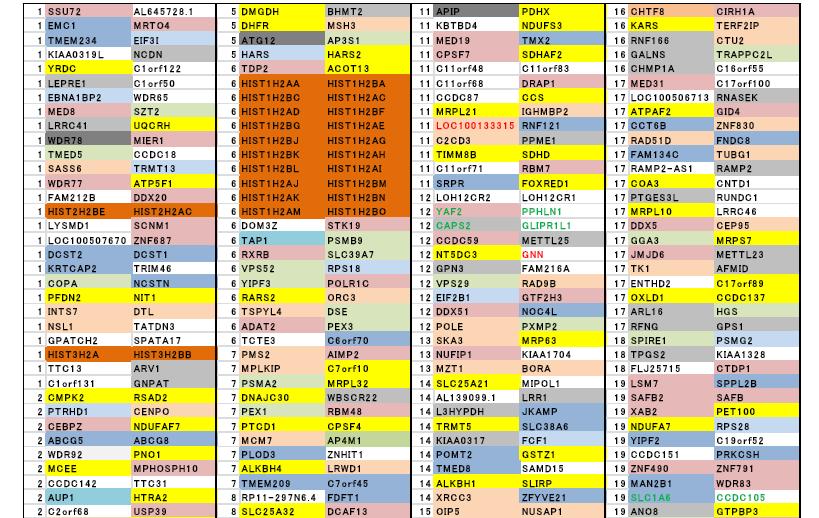
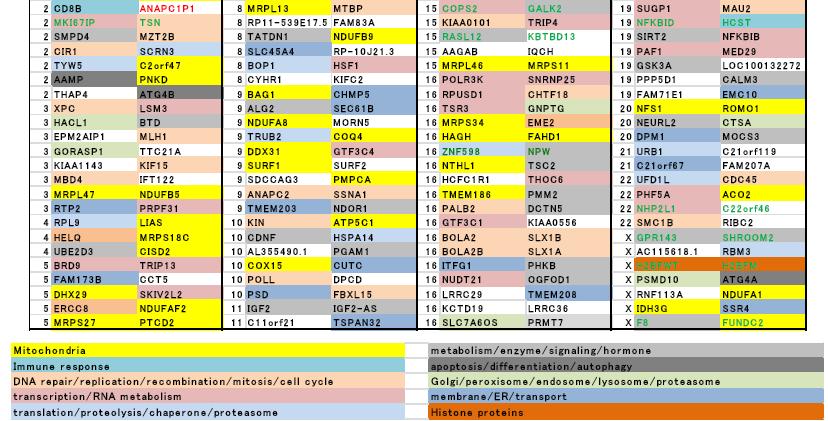
 DownLoad:
DownLoad: 